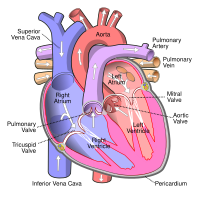
Photo from wikipedia
https://e-kcj.org A 69-year-old woman presented with aggravated dyspnea classified as New York Heart Association class IV. She had undergone transcatheter aortic valve replacement (TAVR) with a 26-mm CoreValve (Evolute-RTM, Medtronic,… Click to show full abstract
https://e-kcj.org A 69-year-old woman presented with aggravated dyspnea classified as New York Heart Association class IV. She had undergone transcatheter aortic valve replacement (TAVR) with a 26-mm CoreValve (Evolute-RTM, Medtronic, NY, USA) 17 months prior to presentation. Two months previously, she had been admitted for acute pyelonephritis. Blood cultures during this period of hospitalization revealed methicillin-susceptible Staphylococcus epidermidis. One month previously, she had been admitted again for septic arthritis and had received arthroscopic debridement for the right knee. Transthoracic echocardiography revealed severe transvalvular regurgitation (regurgitation volume >51 mL, effective regurgitant orifice area=0.4 cm2) without any vegetation (Figure 1 and Supplementary Video 1). Transesophageal echocardiography (TEE) also revealed eccentric transvalvular regurgitation without abnormal leaflet thickening (Figure 1 and Supplementary Video 2). A contrast filling defect, in the region where the regurgitation flow was observed using TEE, was observed in computed tomography (Figure 1). Based on the echocardiographic findings, the patient was diagnosed with transcatheter heart valve failure.1) We decided to perform surgery not only for the correction of transvalvular regurgitation, but also for the benefit of cankerous tissue Korean Circ J. 2019 Jul;49(7):642-643 https://doi.org/10.4070/kcj.2018.0457 pISSN 1738-5520·eISSN 1738-5555
Journal Title: Korean Circulation Journal
Year Published: 2019
Link to full text (if available)
Share on Social Media: Sign Up to like & get
recommendations!